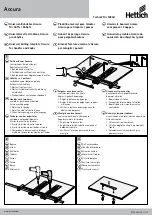
16
4. Before applying final torque, check to make
sure mill head is perpendicular to worktable.
5. Set up a dial indicator in a collet and secure
using draw bar (see Figure 10-5).
Figure 10-5: Test perpendicularity
6. Put spindle drive in neutral (D, Figure 9-1).
7. Set dial indicator plunger on worktable. Zero
the indicator.
8. Rotate spindle 180 degrees (when rotating,
raise dial indicator plunger by hand to prevent
it from dropping into table T-slots).
9. Read dial indicator – it should read zero. If not,
loosen the four hex nuts (A) and reposition mill
head.
10. Recheck perpendicularity using dial indicator.
Repeat procedure above until dial indicator
reads zero in both positions.
Be sure to apply torque in two
steps using a crossing pattern. Failure to do so
could distort face of ram adapter.
11. Tighten the four hex nuts (A). Tighten in two
steps using a calibrated torque wrench. Use a
crossing pattern to tighten the nuts. Tighten
initially to 25 foot-pounds, then tighten to a
final torque of 50 foot-pounds.
10.7
Mill head – front/back tilt
Setting the angle:
1. Loosen three ram adapter locking bolts (E
1
,
Figure 10-6). There is no need to loosen the
bolts more than one-half (1/2) turn to allow
tilting.
Figure 10-6: Mill head movement – tilting
2. Support mill head with your free hand. Press
upward on spindle when tilting.
3. Turn ram adapter worm nut (E
2
, Figure 11) to
tilt head forward and backward. Use scale on
ram adapter (E
3
) to locate desired angle.
Returning to upright position:
1. When returning mill head to full upright
position, support head by upward pressure on
spindle as you turn worm nut.
2. Check to make sure mill head is perpendicular
to worktable.
3. Set up a dial indicator in a collet and secure
using draw bar (see Figure 10-5).
4. Put spindle drive in neutral.
5. Set dial indicator plunger on worktable. Zero
the indicator.
6. Rotate spindle 180 degrees. (When rotating,
raise dial indicator plunger by hand to prevent
it from dropping into the table T-slots).
7. Read dial indicator. The indicator should read
zero. If not, loosen locking bolts (E
1
, Figure 11)
and reposition mill head.
8. Recheck perpendicularity using dial indicator.
Repeat procedure above until dial indicator
reads zero in both positions.
9. When indicator reads zero, tighten locking
bolts (E
1
, Figure 10-6).
10.8
Ram movement
10.8.1
Ram position fore and aft
Refer to Figure 10-7.
1. Loosen hex nuts (G, Figure 10-7) located on
the eccentric locking cylinders.
2. Turn ram pinion (H) with 19mm wrench to slide
ram forward or back.
3. When desired position is reached, tighten hex
nuts (G) securely.
Summary of Contents for JTM-1050VS2
Page 7: ...7 5 0 JTM 1050VS2 Machine dimensions Figure 5 1 machine dimensions...
Page 21: ...21 13 1 1 JTM 1050VS2 Upper Head Assembly Exploded View...
Page 25: ...25 13 2 1 JTM 1050VS2 Lower Head Assembly Exploded View...
Page 29: ...29 13 3 1 JTM 1050VS2 Column and Base Assembly Exploded View...
Page 36: ...36 14 0 Electrical connections for JTM 1050VS2...
Page 38: ...38 This page intentionally left blank...
Page 39: ...39 This page intentionally left blank...
Page 40: ...40 427 New Sanford Road LaVergne Tennessee 37086 Phone 800 274 6848 www jettools com...
















































